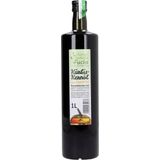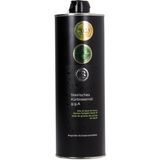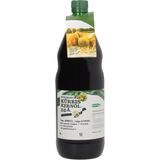Styrian Pumpkin Seed Oil - Healthy and Tasty
Pumpkin seed oil has become indispensable in Styrian cuisine. Meanwhile, it is also widely popular outside of Austria. The healthy ingredients and the outstanding taste of this extraordinary specialty make it an extremely popular oil.
The green gold of Styria, the pumpkin seed oil, has earned an international reputation for quality over the last few years. Pumpkin seed oil is extracted from the seeds of the Styrian oil pumpkin. This special pumpkin has no woody seed coat. The seeds are surrounded only by a fine silver skin, which is responsible for the characteristic color. This pumpkin has been specially bred for its properties.
The Story of Pumpkin Seed Oil
The first written evidence of the production of pumpkin seed oil dates back to 1735. At that time, the Styrian oil pumpkin did not exist without a seed coat. The oil was so precious that it could only be used by pharmacies for the preparation of medicine.
In 1773, pumpkin seed oil was even banned for use as a cooking oil because it was too valuable.
Once farmers successfully bread a pumpkin without a woody seed coat, this variety spread throughout Styria. Within a decade, the pumpkins were extremely popular. For a long time thereafter, the oil was pressed only for consumption by individual farmers. In the 1970s, it was not known outside of the Styria. From the eighties on, that changed, and today pumpkin seed oil is known and appreciated in many countries.
In addition to its characteristic dark green color, pumpkin seed oil also has a distinctive nutty taste. Through many valuable ingredients, such as the minerals zinc, selenium and potassium and the vitamins A, C, D, and several of the B group vitamins, the oil is very healthy. What's more, that it consists of 80 percent unsaturated fatty acids, and it has an antioxidant effect.
Pumpkin seed oil should help to reduce cholesterol and blood pressure and also helps in bladder and prostate conditions.
Production
The pumpkin harvest takes place in autumn. Here the cores of the pumpkin seeds are separated from the pulp. Mostly this is done nowadays by machines, but smaller scale farmers, still clean the seeds by hand. After washing and drying, the cores are storable. This separates the pumpkin seed oil from many other oil, as fruit like olives cannot be stored for long and must be pressed immediately.
After the oil is pressed, the seeds are ground and mixed with water and salt. This slurry is gently roasted until the water evaporates. The remaining mass of the oil cake is now pressed. Earlier it was hard work. The "Styrian Ölkuh" press that was used was a massive wooden device. Seeds were placed between two wedges and hammered down to release their oil. Due to the fact that this work was so labor intensive, hydraulic presses have been used since the 19th Century. About 2.5 kilos of pumpkin seeds are required for one liter of oil. Between 30 and 35 pumpkins are needed for this quantity of seeds.
Use
The oil is classically used as a salad dressing in Austria. However, it is also used for decorating and flavoring appetizers, main courses and even desserts.
The pumpkin seeds themselves are very often used as decorations, crusts or ingredients in brittles.
There is only one restriction in using this oil: pumpkin seed oil should not be heated. Therefore, it is not used for cooking and frying, but should be added after cooking.
A Few Recipes:
Pumpkin Seed Oil Marinade
You need:
200 ml pumpkin seed oil
100 ml balsamic vinegar
300 ml stock (vegetable or beef broth)
½ tsp mustard
½ tsp salt
1 pinch of sugar
1 pinch of pepper (freshly ground)
Stir the spices into lukewarm broth, then stir in the vinegar and oil with a whisk. Add more spices to taste. The marinade can be kept in the refrigerator for up to two weeks. Always stir before using, because the oil settles.
Excellent for salads of all kinds.
Scrambled Eggs with Pumpkin Seed Oil
Take for 1 serving:
3 eggs
2 tablespoons vegetable oil
1 tbsp pumpkin seed oil
Salt and pepper
Crack and beat the eggs. Add salt. Then heat the vegetable oil in a pan, and stir in the eggs. Scramble.
Sprinkle the scrambled eggs with pumpkin seed oil and add pepper to taste.
Pumpkinseed Dumplings
Take for 6 servings:
For the dough:
150 g wheat semolina
350ml milk
30g butter
1 tablespoon sugar
½ vanilla pod
1 lemon (untreated, zest)
1 egg
1 egg yolk
Salt
For the filling:
100 g marzipan
50 g pumpkin seeds (roasted and ground)
30ml Amaretto
For the breadcrumbs:
200g butter
100 g pumpkin seeds (roasted and ground)
50g breadcrumbs
1 tablespoon vanilla sugar
Cinnamon
Melt the butter in a pan, and add the wheat semolina. Boil the milk with salt, sugar and the pith of the vanilla bean. Add the lemon zest, then strain and pour over the semolina butter mixture. Stir until the mass comes away from the edges of the pan and allow to cool shortly. Then stir in the egg and egg yolk.
For the filling, mix the marzipan, the pumpkin seeds and the Amaretto and form 1 cm balls. Let cool.
Shape the semolina mixture into small balls, flatten and fill it with the pumpkin seed marzipan. Shape into dumplings and cook for 10 minutes in simmering salted water (water shouldn't be boiling at this point).
Heat the butter in a pan. Add pumpkin seeds, crumbs, vanilla sugar and cinnamon then mix and fry crisp.
Drain the dumplings and roll them in the breadcrumbs.
Related products
-
 4.8 (6)
4.8 (6)Naturprodukte Fuchs Pumpkin Seed Oil PGI, 1 l
-3%- A culinary specialty
- Unique taste
- Thick & dark green in colour
€ 22,21 € 22,99 (€ 22,21 / l)Delivery by April 17
-
 5.0 (25)
5.0 (25)Berghofer Josef Styrian Pumpkin Seed Oil in a Tin, 1.000 ml
- 100% pure pumpkin seed oil from the first pressing
- From Austria
- Perfect for travelling
€ 26,99 (€ 26,99 / l)Delivery by April 17
-
 4.9 (76)
4.9 (76)Bauernhof JÖBSTL, vulgo STINDL Styrian Pumpkin Seed Oil PGI, 1.000 ml
Bestseller- 100% pure Styrian pumpkin seed oil PGI.
- Gold medal winner with the highest points 20 years in a row
- Gault&Millau Award 2019, 2020 & 2023
€ 26,99 (€ 26,99 / l)Delivery by April 17
Magazine Articles:
Discover Piccantino :
-
Austria: Free standard delivery from € 49,90
-
Free
returns -
24-hour shipping
More than 11.500 products
